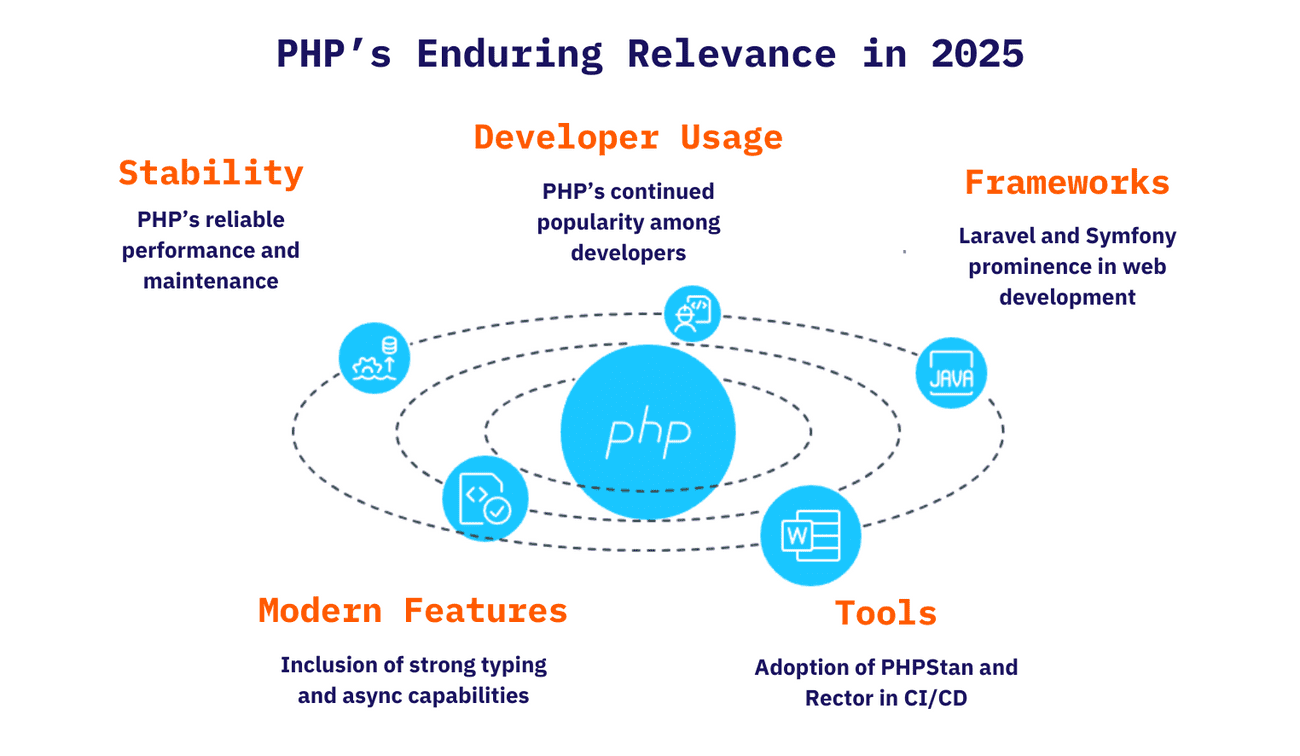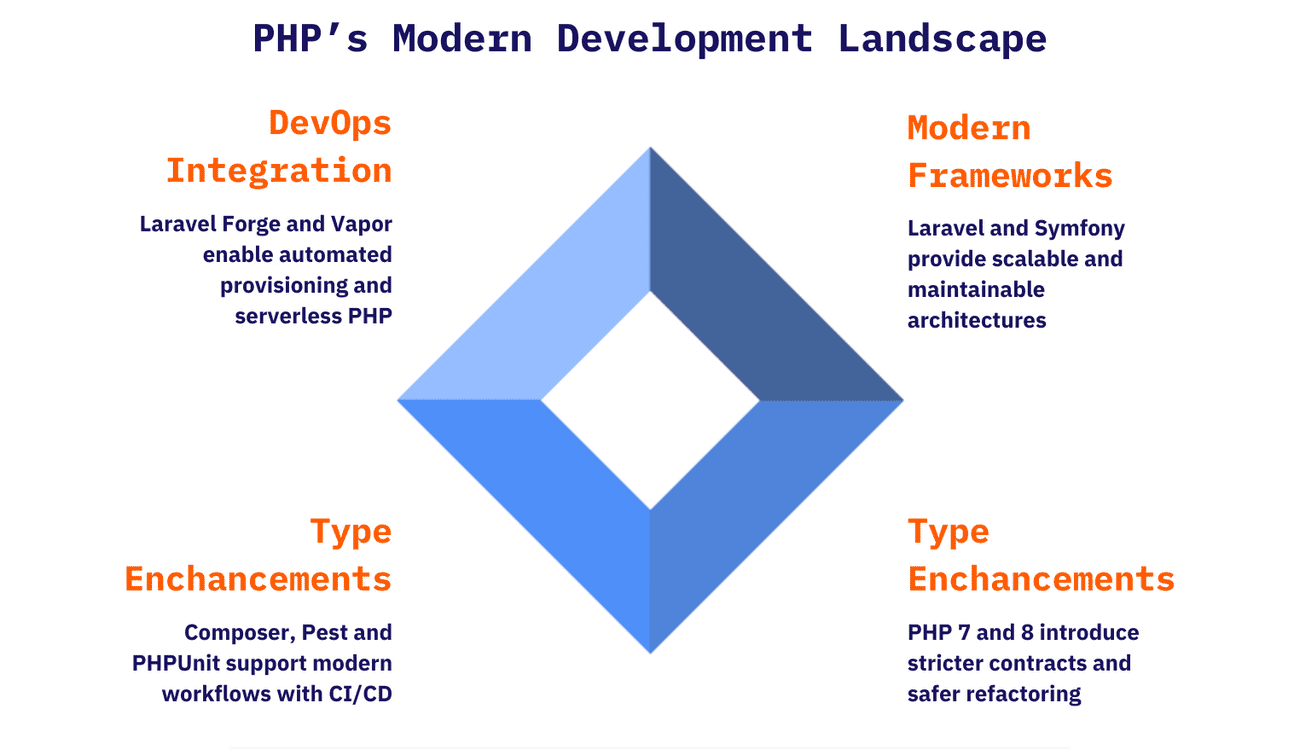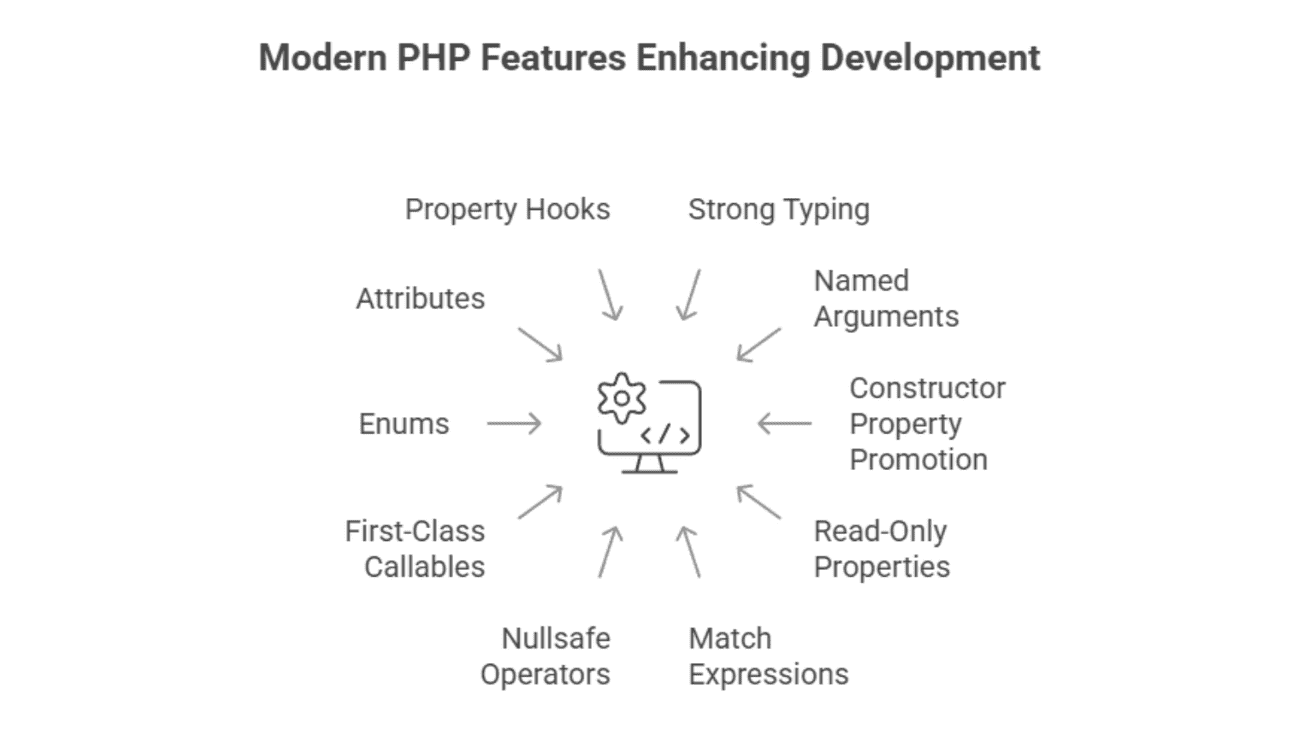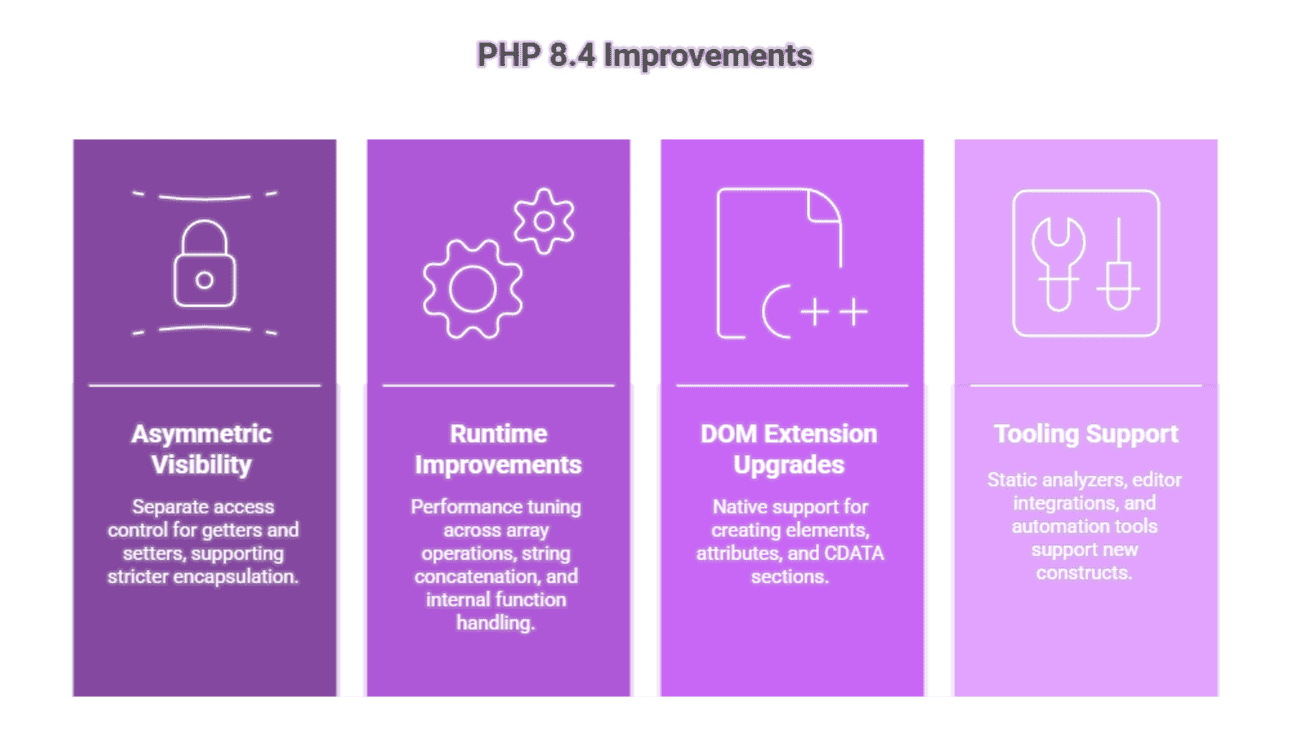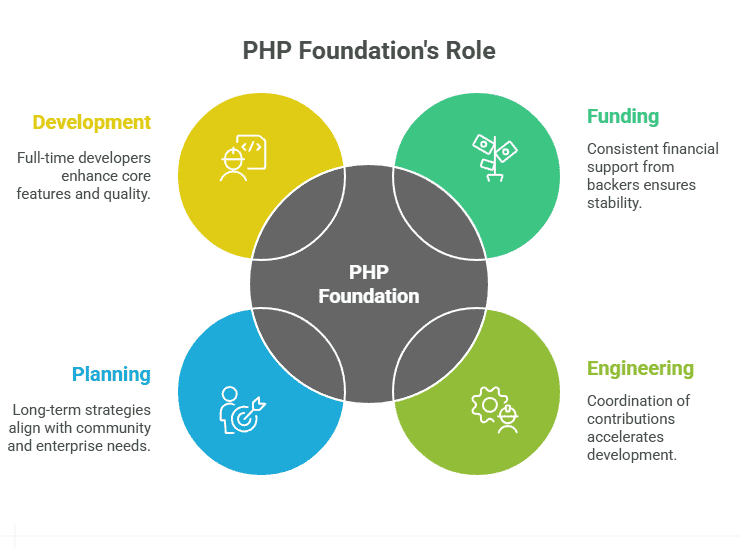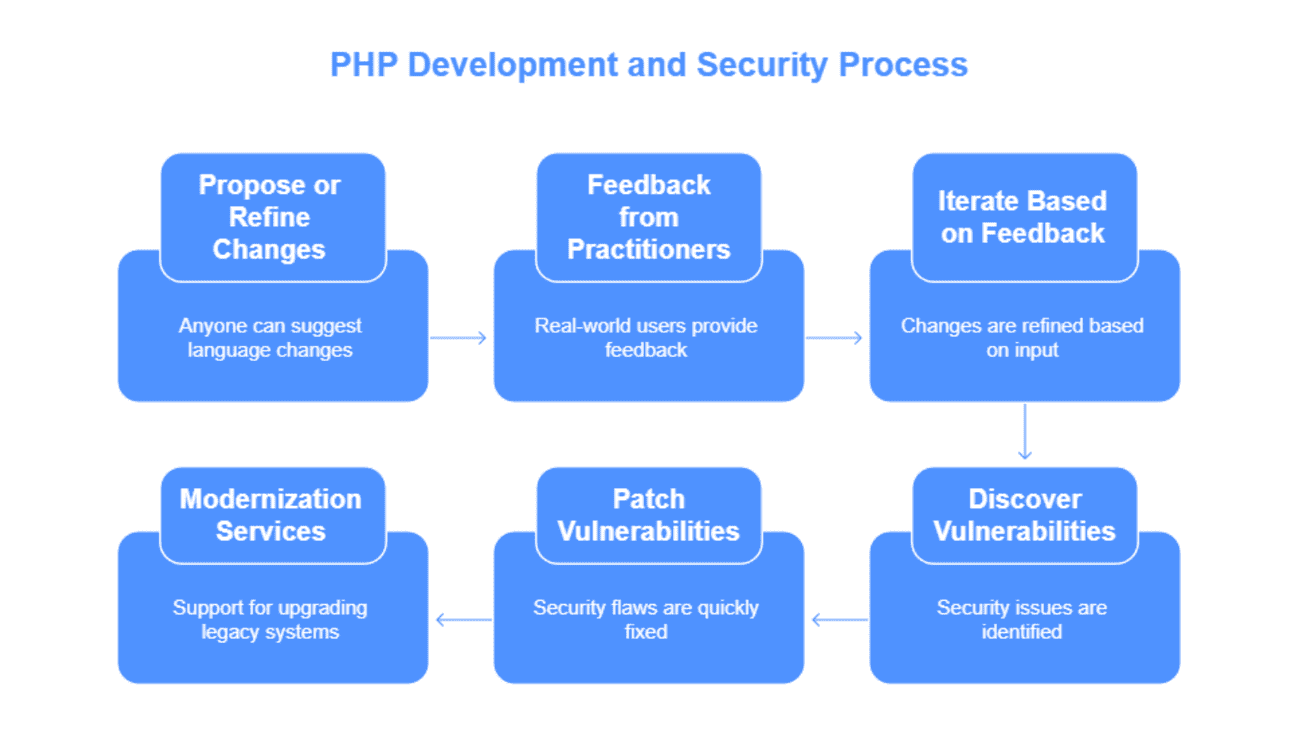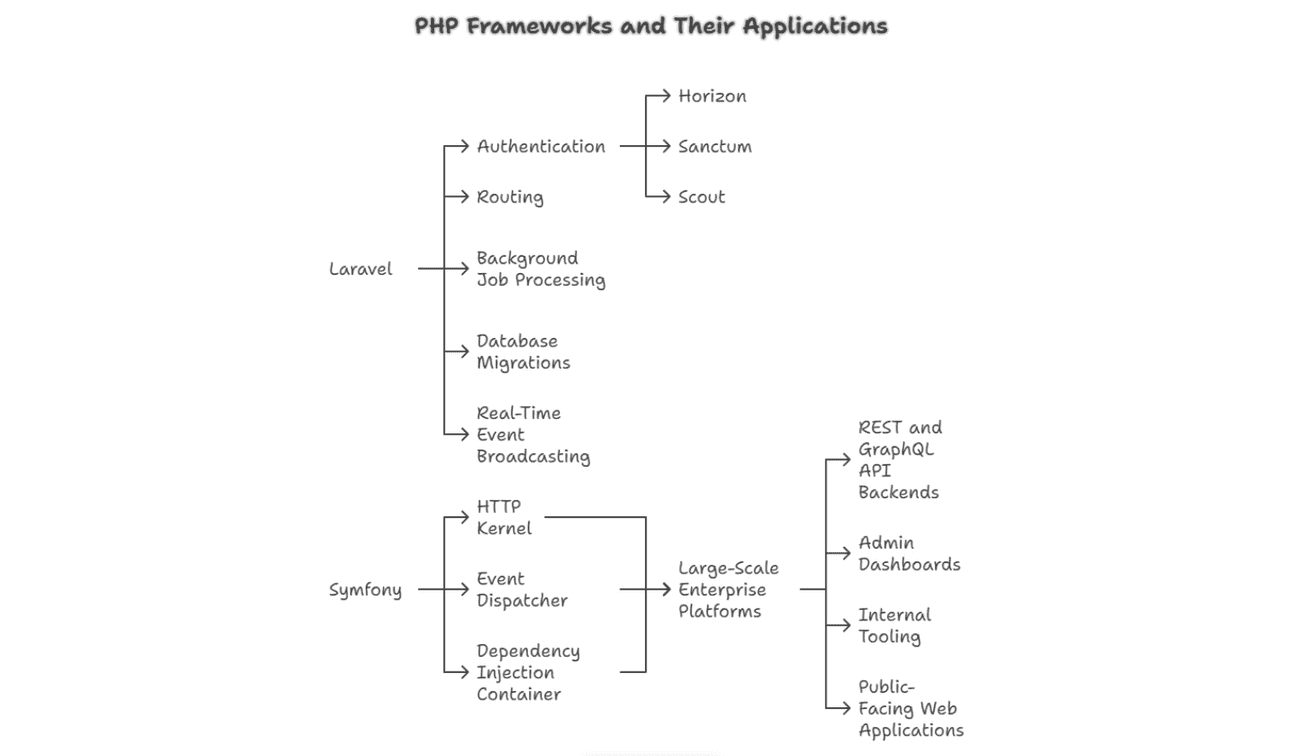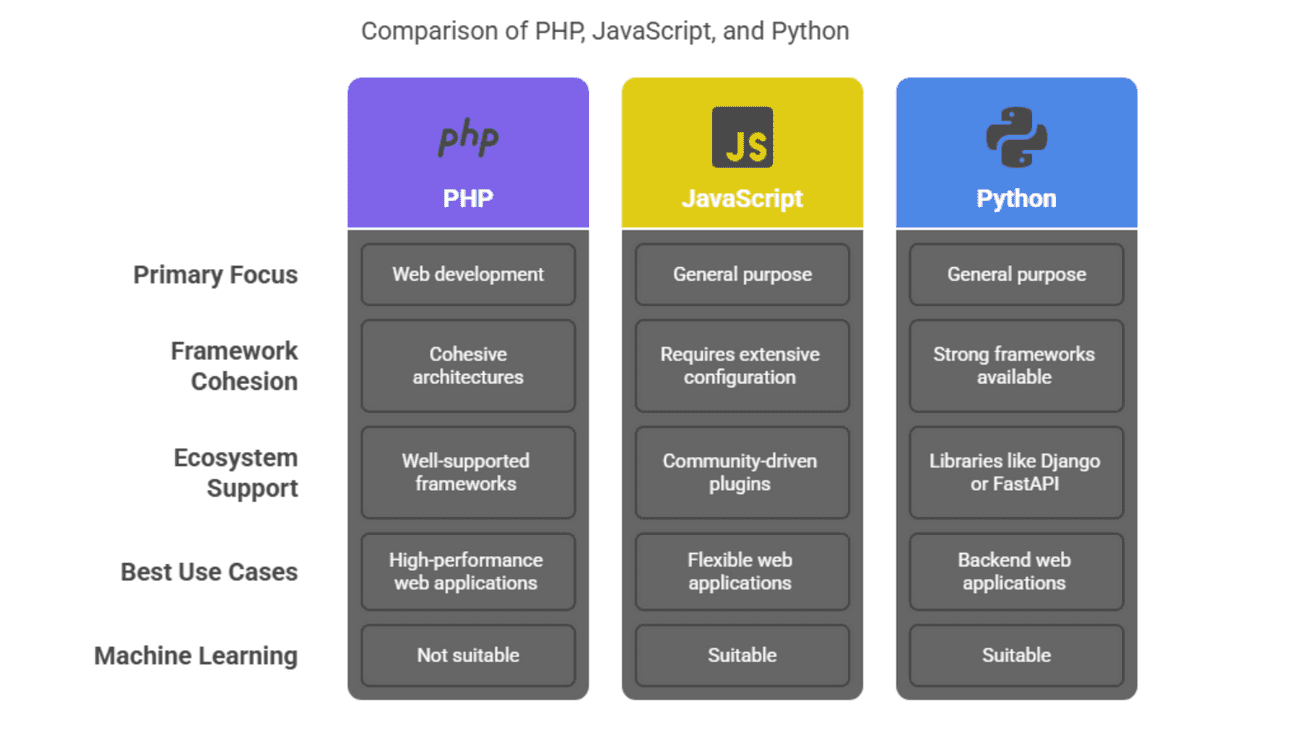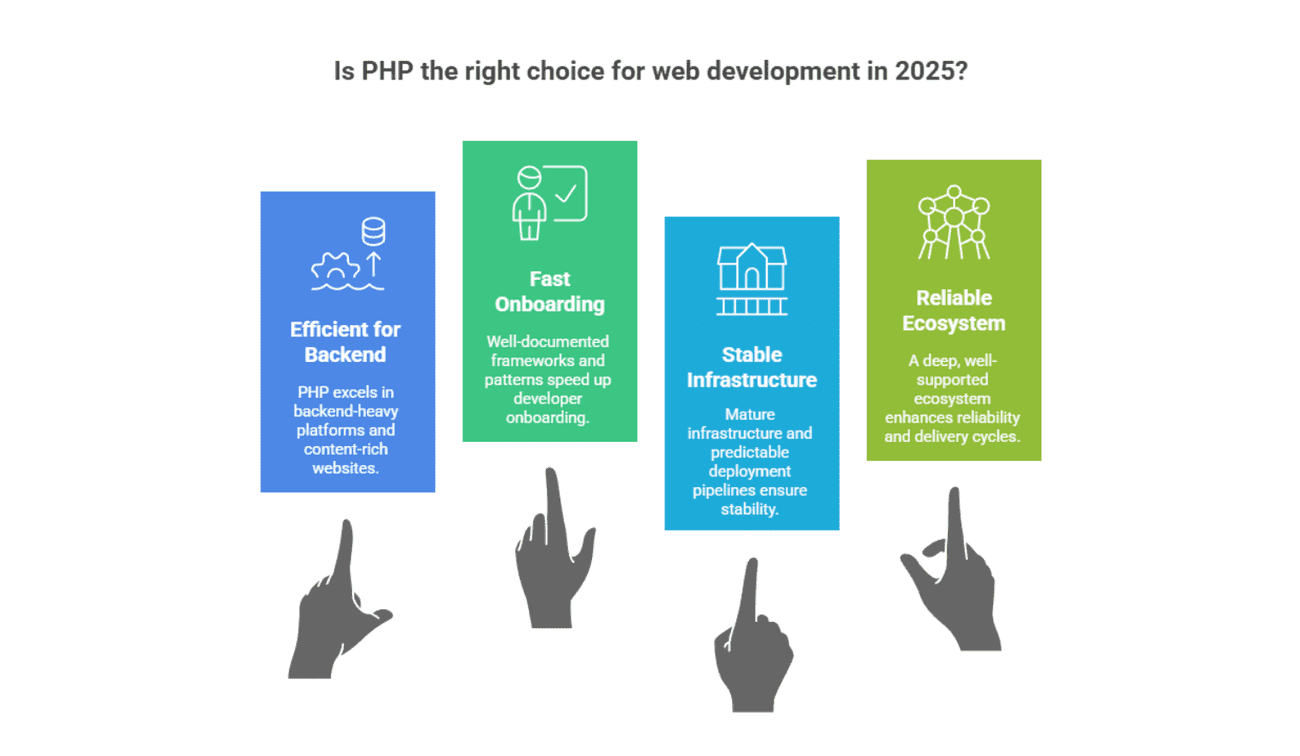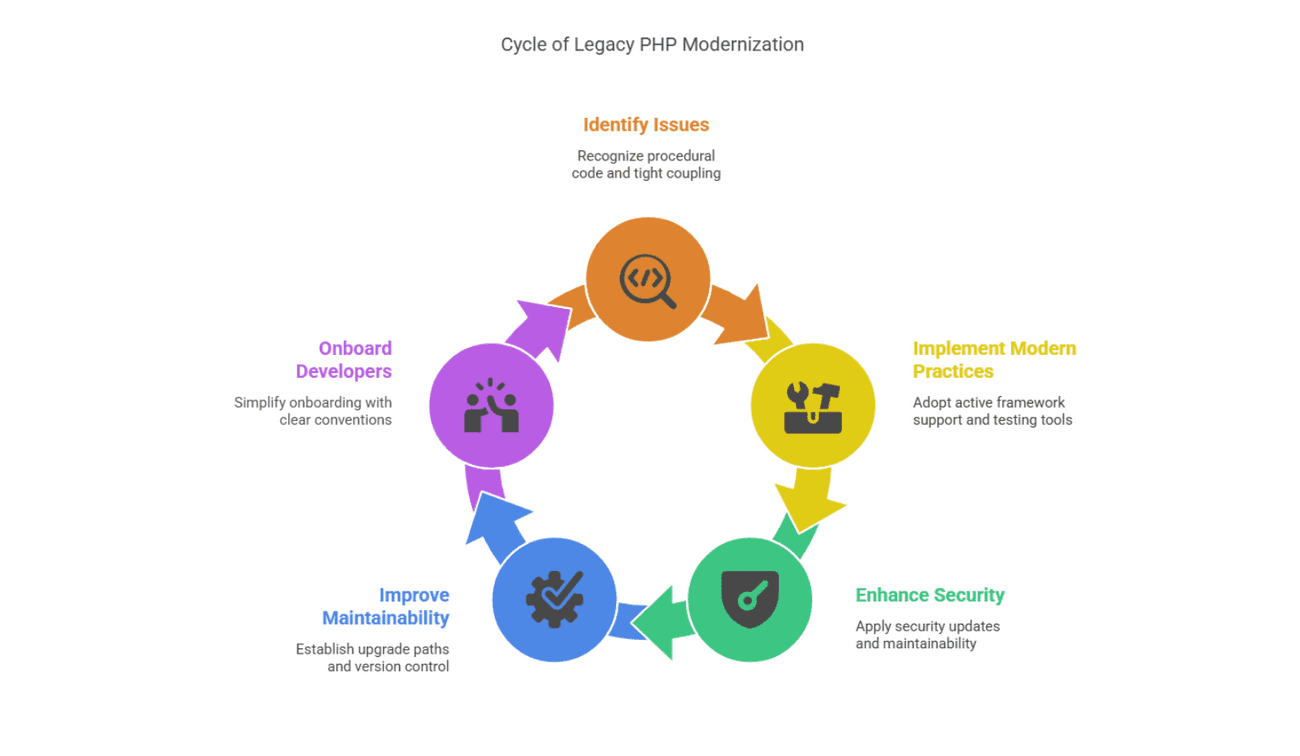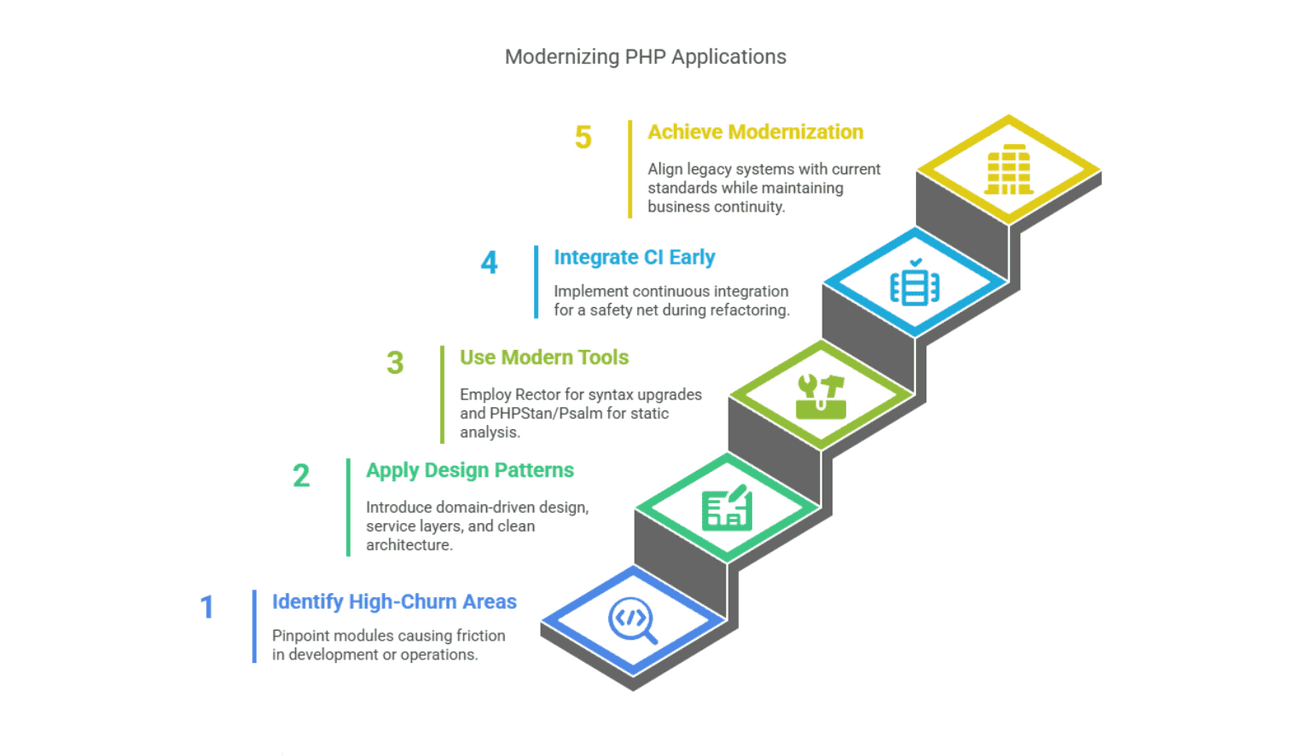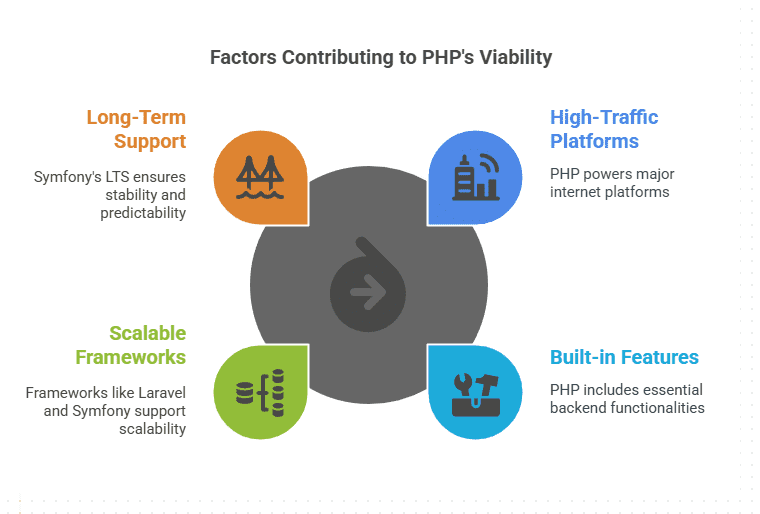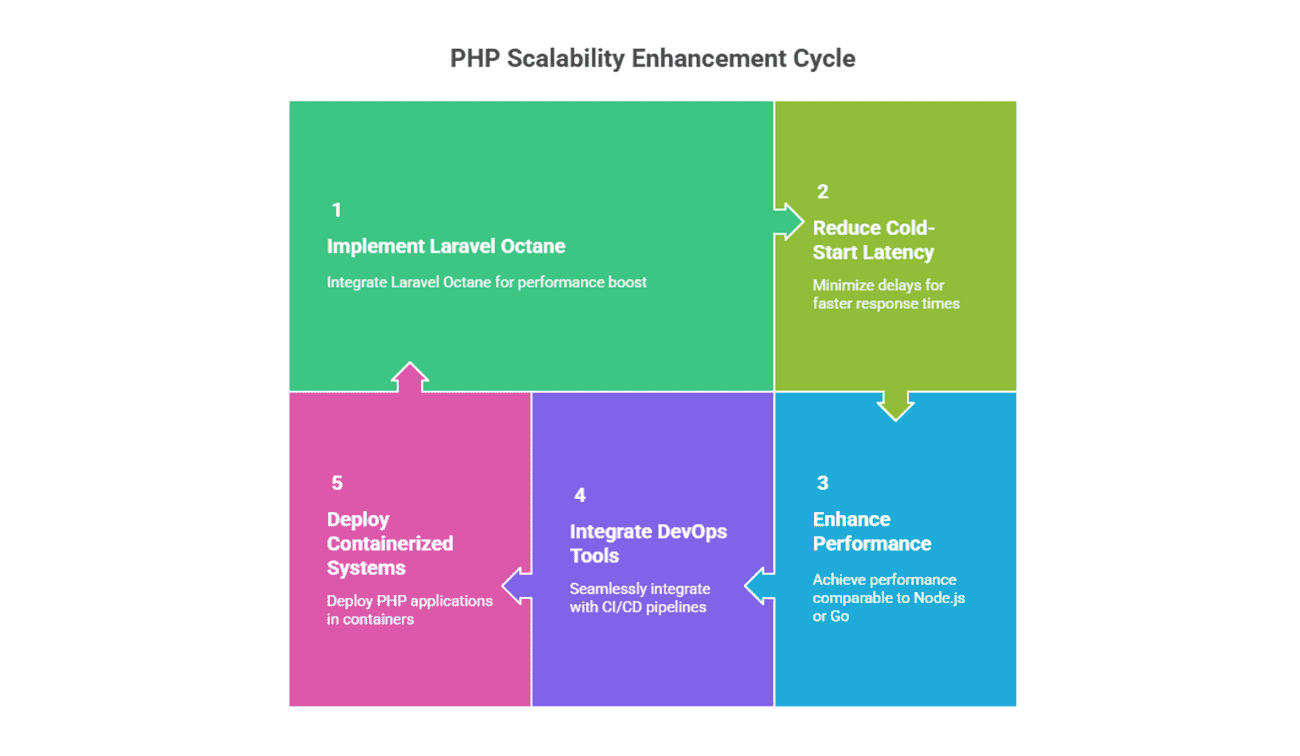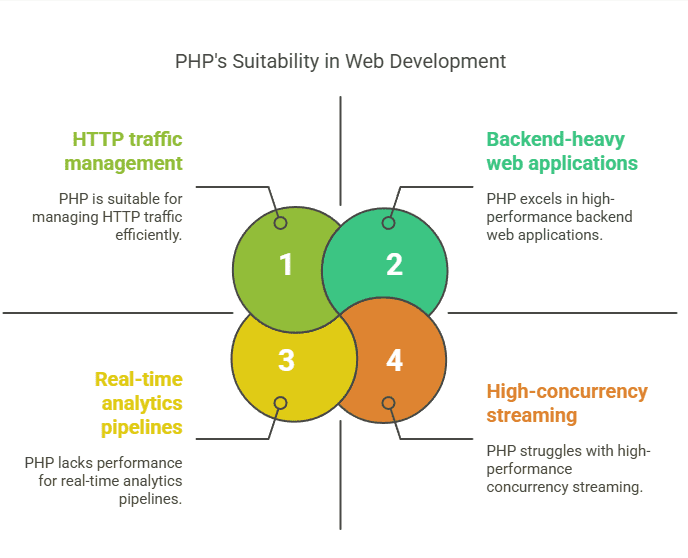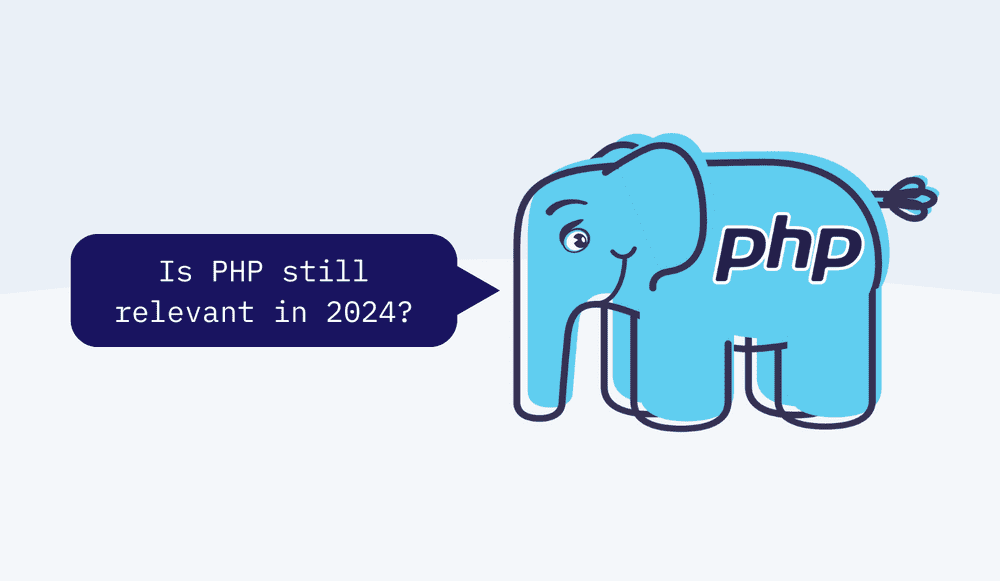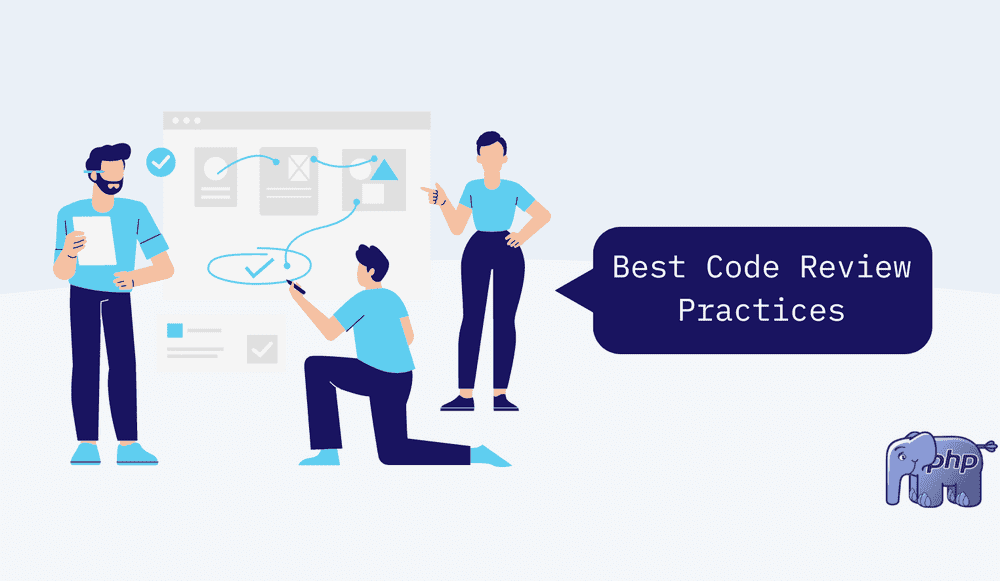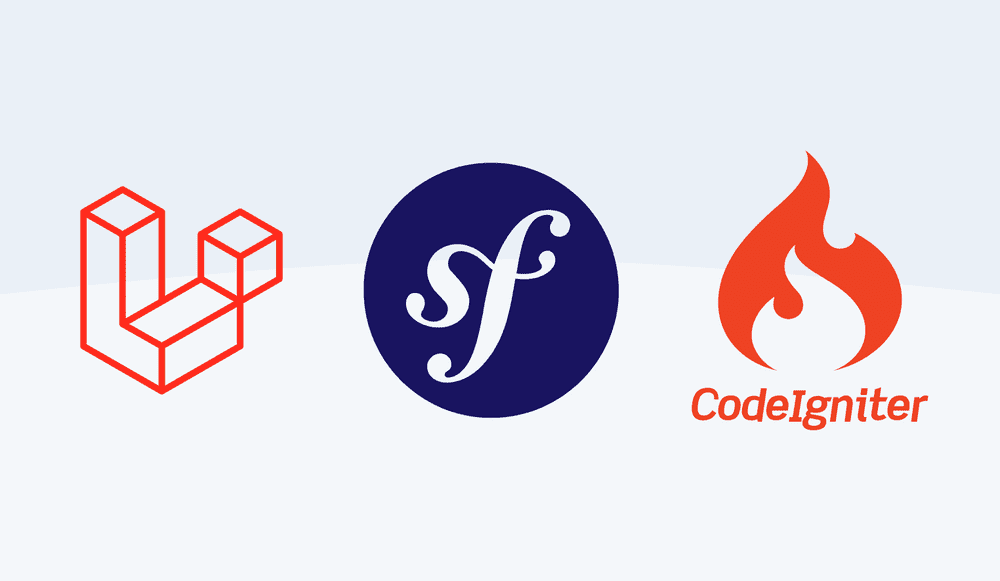Evaluating PHP in 2025: Powerhouse for Modern Web Development
PHP doesn’t need defending in 2025. The language is stable, actively maintained, and deeply integrated into production systems across industries. PHP remains widely used in 2025 because it consistently delivers for teams building web applications at scale.
Recent developer reports back that. JetBrains’ 2024 survey shows PHP is used by nearly 1 in 5 backend developers. Laravel ranks among the top 10 most widely used web frameworks, and tools like PHPStan and Rector are experiencing steady adoption in CI/CD pipelines across enterprise stacks.
The ecosystem is also expanding into new domains. NativePHP brings PHP into native desktop application development, extending its reach beyond the browser. Franken PHP introduces a high-performance execution model with built-in concurrency support, making it easier to deploy modern, scalable applications. These innovations reflect how PHP continues to evolve and adapt to modern development needs. This article reviews PHP in 2025 - what’s improved, where it works best, and why PHP remains a solid choice for modern backend systems.
PHP Is a Core Driver of Modern Web Development
PHP’s role in the modern web has expanded from powering content management systems to supporting full-scale application architectures.
It’s a core part of today’s backend infrastructure, often running behind load balancers, reverse proxies, and containerized environments across industries.
The language has evolved significantly in recent years, introducing better performance, stronger type safety, and a robust ecosystem that aligns with modern development standards.
PHP Powers the Modern Web
Modern frameworks, such as Laravel and Symfony, support scalable and maintainable architectures for PHP developers. Laravel offers built-in features like ORM, queues, job dispatching, API scaffolding, and real-time event handling with Echo, while Symfony’s component-driven structure powers many large-scale enterprise systems.
Type enhancements in PHP 7 and 8, including union types, enums, readonly properties, and attributes, enable stricter contracts and safer refactoring. These changes improve type safety, enable safer refactoring, and make PHP fully compatible with tools like PHPStan and Psalm, reducing technical debt in larger codebases.
PHP’s tooling ecosystem is mature. Composer manages dependencies, while PHPUnit and Pest — Laravel’s expressive testing framework built on top of PHPUnit — support robust test coverage across projects. Static analysis and code quality tools like PHPStan, PHP CS Fixer, and Deptrac are widely adopted, helping teams maintain clean, safe codebases. On top of that, PHP includes specialized tooling like Behat for behavior-driven development and Infection, one of the few language-native mutation testing frameworks.
On the DevOps side, tools like Laravel Forge and Vapor simplify provisioning, SSL, and serverless deployment. PHP integrates seamlessly with containerized CI/CD pipelines, including GitHub Actions and GitLab CI, enabling fast and reliable release cycles.
Modern PHP Development: Language Improvements That Changed Everything
PHP’s modern syntax and expanding type system have significantly raised its floor for professional development and as a programming language. As a programming language, PHP has evolved with features introduced in 7.4 and refined through 8.4 now align with modern expectations for maintainability, performance, and production-grade safety.
Language Features That Make PHP Worth Learning in 2025
Modern PHP development supports strong typing with union types, intersection types, and enums. Named arguments allow more explicit function calls. Constructor property promotion cuts boilerplate, while read-only properties add immutability to class design. These changes reduce cognitive load, making code easier to reason about in larger systems for developers.
The developer ergonomics are better, too. PHP now offers match expressions, nullsafe operators, and first-class callables. Enums eliminate error-prone constant-based patterns, while attributes enable clean, declarative metadata without relying on docblock parsing.
Newer features in PHP 8.4, such as property hooks, give developers fine-grained control over property access, allowing logic to execute automatically when values are read, written, or unset. As a programming language, PHP now supports extensibility patterns familiar to developers coming from Python or C#, without relying on brittle magic methods or workarounds.
One notable change is the introduction of Attributes as a native language feature, replacing comment-based annotations like those used in Doctrine with a cleaner, more robust syntax.
PHP 8.4 Brings More Than Just Syntax
PHP 8.4 introduces asymmetric visibility for class methods, allowing separate access control for getters and setters. This enables stricter encapsulation, especially useful in data transfer objects and value objects that power structured data flow in applications that create dynamic web pages.
PHP’s performance has seen major gains across recent versions. The JIT compiler, introduced in PHP 8, continues to mature and now boosts real-world workloads in specific use cases like math-heavy logic or long-running scripts. Core engine optimizations have reduced memory usage, improved function call efficiency, and accelerated array and string operations. These improvements translate to faster response times and lower server load — especially at scale.
There are also runtime improvements under the hood for developers. Performance has been tuned across array operations, string concatenation, and internal function handling. The DOM extension received long-requested upgrades, including native support for creating elements, attributes, and CDATA sections through a more fluent API.
Tooling has kept pace. Static analyzers like PHPStan and Psalm, as well as automation tools like Rector, and editor integrations such as PhpStorm and Intelephense, now fully support the latest language constructs. PhpStorm, a full-featured professional IDE explicitly built for PHP, offers advanced refactoring tools, deep language support, and seamless integration with testing and deployment workflows. For lighter setups, Intelephense remains a popular extension in VS Code.
PHP Foundation: A Stable Core for the Future
The longevity of PHP as a programming language isn’t accidental. Its continued relevance is driven by a strong PHP community, structured governance, and steady investment from major stakeholders. With the PHP Foundation now firmly established, the language benefits from a clear roadmap and long-term planning that ensure consistent progress and sustainability. This support extends to the continued maintenance of core libraries and PHP extensions, ensuring that development decisions reflect both grassroots usage and enterprise-scale needs.
The Foundation’s Work and Governance
The PHP Foundation plays a central role in maintaining the momentum and recent improvements of the programming language. It provides consistent funding, coordinates engineering contributions, and oversees long-term planning through an open, consensus-driven model. Backers include JetBrains, Laravel, Automattic, Symfony, and other companies whose platforms are powered by PHP in production.
The Foundation also supports full-time developers in working on core features, reviewing patches, and triaging bugs. This reduces bottlenecks and accelerates development without sacrificing code quality.
Community Momentum and Continuous Evolution
PHP continues to play a central role in modern software development, backed by a transparent RFC process that enables real-world practitioners to shape the language through practical, iterative improvement. This creates a feedback loop of practical iteration that few languages sustain after two decades of active use.
PHP’s security posture has advanced significantly in recent years, supported by dedicated Foundation-backed maintainers. In 2025, a comprehensive security audit of the PHP core was conducted by Quarkslab, an independent firm known for deep security expertise. Few open-source ecosystems undergo audits of this scope and depth. All findings were addressed promptly, with coordinated updates and clear communication, reinforcing PHP’s reputation as a mature, production-grade platform trusted by enterprise systems worldwide.
For organizations running legacy PHP versions, modernization services like Accesto’s PHP upgrade support make it easier to stay aligned with the latest language features and security patches.
PHP Frameworks and Tools in 2025
As a server-side programming language, modern PHP offers a fast, predictable, and infrastructure-ready development experience. Its mature frameworks and sophisticated tooling enable teams to build, test, and deploy production applications without workarounds or legacy baggage.
Frameworks Like Laravel and Symfony Keep PHP Competitive
Laravel remains the most popular full-stack framework in the PHP ecosystem. It offers built-in support for authentication, routing, background job processing, database migrations, and real-time event broadcasting. With first-party tools like Horizon (queues), Sanctum (auth), and Scout (search), Laravel reduces time-to-delivery and helps teams scale confidently.
For developers learning PHP today, Laravel provides a clear and approachable entry point, accompanied by excellent documentation, intuitive conventions, and strong community support.
Symfony is more modular and component-driven. It powers many large-scale enterprise platforms and is frequently used as a backend core in projects where flexibility, long-term support, and separation of concerns are critical. Symfony’s HTTP kernel, event dispatcher, and dependency injection container are also widely used outside the full stack, including inside Laravel itself.
Both frameworks are widely used in backend development, powering APIs, dashboards, internal tools, and web apps.
Tooling and Developer Experience
PHP’s tooling has kept pace with modern software development standards, backed by strong community support. With Composer for dependency management and PHPStan, Psalm, and Rector for static analysis and refactoring, PHP continues to offer a robust tooling stack that integrates directly into CI/CD pipelines, supporting fast, reliable delivery in modern development environments.
For those looking to learn PHP today, the ecosystem is more accessible than ever. PHPStorm remains the gold standard IDE for professional developers, not just for its deep language support and powerful tooling, but because JetBrains actively invests in the PHP community. They provide free licenses to maintainers of open source projects, making it easier to sustain and scale high-quality codebases.
VS Code, when paired with the Intelephense extension and LSP integration, offers a lightweight alternative that delivers autocomplete, refactoring tools, and real-time diagnostics, making it easy to get started and grow as your skills develop.
How PHP Compares to Other Technologies in 2025
Modern development depends less on language choice and more on adopting frameworks and tooling that reduce risk, accelerate delivery, and support team scalability. In 2025, PHP frameworks like Laravel and Symfony stand out for their ecosystem maturity, offering structured patterns, long-term support, and a robust set of features that go far beyond basic syntax.
PHP vs JavaScript Frameworks and Python
JavaScript and Python dominate in specific domains, but PHP consistently excels in web development workloads that prioritize speed, stability, and ease of deployment. As a server-side scripting language, PHP provides a mature and cohesive ecosystem ideal for building websites and full-featured web applications.
Frameworks like Laravel and Symfony provide long-term support, well-defined upgrade paths, and built-in tools for queues, authentication, and background tasks, features that are native rather than patched together. In contrast, JavaScript and Python stacks often rely on loosely coupled plugins, leading to higher maintenance overhead.
PHP isn't designed for machine learning or data science. Its strength is web development, where it delivers performance, reliability, and rapid iteration at scale.
When PHP Beats Other Languages
For backend-heavy platforms, content-rich websites, and web-first SaaS tools, PHP remains one of the most efficient and widely adopted choices for web development. Its elegant syntax, well-documented frameworks, and established patterns make developer onboarding fast and intuitive. Infrastructure support is mature, deployment pipelines are predictable, and the runtime is stable across environments.
PHP continues to stand out for its reliability, rapid delivery cycles, and rich ecosystem, making it a practical backbone for scalable web development in 2025 and beyond.
Real-World Scale: How Slack and Tumblr Use PHP
Major platforms like Slack and Tumblr have embraced PHP in production environments, handling massive traffic and complex infrastructure.
Slack rebuilt large portions of its backend using PHP, choosing the language for its developer experience, reliability, and ecosystem maturity. In their “Taking PHP Seriously” post, Slack engineers describe PHP as a high-leverage, pragmatic choice that let them move fast without compromising stability. They built a custom PHP runtime embedded in a Go-based container, enabling them to deploy fast, testable services with strong observability and performance. For Slack, PHP offered the right balance of runtime predictability and tooling flexibility, especially in high-scale, request-heavy environments.
Tumblr, serving over 15 billion page views per month, also runs on PHP at scale. In their architecture deep dive, they highlight how PHP’s simplicity, horizontal scalability, and compatibility with systems-level tools like NGINX, HAProxy, and Varnish made it ideal for a web-first content platform. Tumblr scaled their stack with PHP-FPM behind load balancers and embraced asynchronous processing through gearman queues and caching layers, showing PHP’s effectiveness in powering massive, dynamic workloads.
Both platforms chose PHP not as a fallback but because it met the technical demands of scale, developer velocity, and infrastructure integration. These are real proof points that modern PHP is engineered for high-performance environments and not just legacy workloads.
Legacy Systems and PHP Modernization
Despite PHP’s evolution, many organizations run legacy code with outdated patterns. The real challenge isn’t the language, it’s the gap between old code and modern frameworks like Laravel or Symfony. Modernizing within PHP lets teams preserve institutional knowledge while adopting current best practices for web development.
What Holds PHP Back
Legacy PHP applications often rely on procedural code, tight coupling, and global state, making them hard to test, extend, or refactor. Many developers still use outdated magic methods and autoloading, which obscures behavior and complicates onboarding, compared to the cleaner patterns seen in newer languages.
These systems often lack automated tests and version control hygiene. Unmaintained frameworks with no security updates increase risk across both code quality and uptime. Modern PHP development addresses these issues through the use of supported frameworks, robust testing tools, built-in authentication, and clear upgrade paths, ensuring long-term maintainability.
Building a Path Forward with Modern Practices
Rewriting large legacy systems like custom CMS platforms is rarely practical. Incremental modernization, utilizing domain-driven design, service layers, and clean architecture, enables teams to enhance existing logic without compromising functionality. Most start by isolating high-churn areas that cause the most friction.
Tools like Rector can assist with syntax upgrades and code transformation. Static analysis with PHPStan or Psalm helps identify risky patterns before they escalate into bugs. Early CI integration, even in legacy projects, gives teams the safety net needed to refactor with confidence.
Modernizing legacy PHP applications involves applying current best practices and tooling to bring aging code into line with today’s web development standards, while preserving the systems that deliver value.
PHP-Based Systems at Scale
Despite misconceptions, PHP remains a powerful tool for building large, complex systems across e-commerce, publishing, SaaS, CMS platforms, and enterprise IT. Its runtime is stable, its ecosystem is mature, and its frameworks support the scalability and modularity modern web development demands from any production-grade stack.
Enterprise Applications Built with PHP
PHP powers many of the internet’s highest-traffic platforms, including e-commerce engines, CMSs, and internal systems. With built-in session management, caching, cookies, and authentication scaffolding, it streamlines backend development and reduces external dependencies, offering capabilities expected from modern languages and remaining a pragmatic choice for web development.
Modern PHP frameworks and language features enable scalable architecture. Laravel and Symfony offer first-class support for job queues, event broadcasting, and distributed caching. With built-in support for horizontal scaling via containers or serverless platforms, PHP competes directly with newer languages in high-availability web applications.
Symfony’s long-term support (LTS) releases, maintained for up to eight years, provide architectural stability and predictable upgrade paths. This level of support is crucial in enterprise environments where systems must remain operational long-term, especially those handling critical workloads like APIs, integrations, and background tasks at scale.
PHP for Web Apps in the Near Future
The idea that PHP doesn't scale is outdated - at least for traditional web applications. Today’s PHP developers are leveraging frameworks like Laravel Octane, powered by Swoole or RoadRunner, to push PHP into high-performance territory with persistent workers and reduced cold-start latency. This setup makes PHP competitive for typical request-driven workloads, especially in high-throughput, backend-heavy environments.
These tools eliminate traditional bottlenecks in PHP’s request-response cycle, giving it performance characteristics similar to Node.js or Go in many web-centric scenarios. Combined with DevOps-ready tooling, PHP now integrates cleanly into CI/CD pipelines and containerized deployments, reinforcing its position as a go-to language for scalable, production-ready backend systems.
When PHP Isn’t the Right Fit
PHP performs well in high-throughput web applications, especially when paired with tools like Swoole or RoadRunner to enable persistent workers and reduce latency. But outside of that context, it’s still not the best tool for everything.
For workloads that are inherently concurrency-heavy like real-time analytics, WebSockets, or stream processing. Languages with native async runtimes like Go, Rust, or Node.js are better suited. PHP can approximate this behavior through extensions, but those setups come with operational complexity and edge-case limitations.
Machine learning is another area where PHP lags. Python continues to dominate due to its mature ecosystem of libraries, frameworks, and community support.
In short: PHP can be extended to handle more, but that doesn't always mean it should be, especially when concurrency or ML is core to the product.
PHP’s Long-Term Advantage for Web Applications
In 2025, PHP is fast, stable, and more maintainable than ever, retaining the simplicity that made it successful while evolving to meet modern web development needs.
Frameworks like Laravel and Symfony provide architectural consistency, and tools like PHPStan, Rector, and CI/CD pipelines make refactoring and deployment safer at scale. PHP fits seamlessly into modern workflows, backed by a community focused on stability and long-term support.
At Accesto, we collaborate with PHP developers and teams that are ready to modernise their legacy systems. We’ve helped companies modernize thousands of lines of legacy PHP into well-structured, scalable, and testable systems - without throwing everything away and starting from scratch.
If your product is held back by outdated code, we can help.
